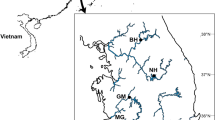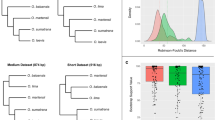Abstract
Recent reports indicate an extensive amount of molecular evolution separating cryptic taxa as well as significant population structure at a microgeographical scale. Appropriate molecular markers are particularly suitable for distinguishing cryptic biological species. In this study, we examine the phylogenetic utility of 16S rRNA in elucidating the evolutionary relationships within the recently described euryhaline Brachionus plicatilis species complex. In addition, we assess the applicability of this marker in the genetic identification and monitoring of rotifer populations. We have sequenced a 378-bp fragment of the mitochondrial 16S rRNA gene in laboratory reference strains, hatchery clones as well as collections from a wild population of the subsaline Lake Koroneia (Northern Greece). Also, restriction fragment length polymorphism (RFLP) analysis was performed with eight restriction endonucleases. Rotifer samples are distinguished into six genetically divergent lineages. Average sequence divergence between lineages is 0.1038. The evolutionary relationships and divergence time-scales revealed with the 16S sequence data are in agreement with previous analyses using different mitochondrial and nuclear markers. The 16S region appears to have several advantages over other regions of the genome regarding use of species-specific primers, ease of amplification from single specimens and undiluted informational content over both recent and more ancient separations. It has also exhibited maximum discriminatory power (100% success) between lineages during RFLP analysis. The 16S assayed region has proven especially informative and consistent in detecting, supporting and establishing the lineage status within the B. plicatilis species complex both from a phylogenetic perspective and as an identification tool.




Similar content being viewed by others
References
Abatzopoulos TJ, Beardmore JA, Clegg JS, Sorgeloos P (2002a) Artemia: basic and applied biology. Kluwer, Dordrecht
Abatzopoulos TJ, Kappas I, Bossier P, Sorgeloos P, Beardmore JA (2002b) Genetic characterization of Artemia tibetiana (Crustacea: Anostraca). Biol J Linn Soc 75:333–344
Baxevanis AD, Abatzopoulos TJ (2004) The phenotypic response of ME2 (M. Embolon, Greece) Artemia clone to salinity and temperature. J Biol Res 1:107–114
Baxevanis AD, Triantaphyllidis GV, Kappas I, Triantafyllidis A, Triantaphyllidis CD, Abatzopoulos TJ (2005) Evolutionary assessment of Artemia tibetiana (Crustacea, Anostraca) based on morphometry and 16S rRNA RFLP analysis. J Zool Syst Evol Res (in press)
Carmona MJ, Gómez A, Serra M (1995) Mictic patterns of the rotifer Brachionus plicatilis Müller in small ponds. Hydrobiologia 313/314:365–371
Chu KH, Ho HY, Li CP, Chan TY (2003) Molecular phylogenetics of the mitten crab species in Eriocheir, sensu lato (Brachyura, Grapsidae). J Crustacean Biol 23:738–746
Ciros-Pérez J, Gómez A, Serra M (2001) On the taxonomy of three sympatric sibling species of the Brachionus plicatilis (Rotifera) complex from Spain, with the description of B. ibericus n. sp. J Plankton Res 23:1311–1328
Colbourne JK, Hebert PDN, Taylor DJ (1997) Evolutionary origins of phenotypic diversity in Daphnia. In: Givnish TJ, Systma KJ (eds) Molecular evolution and adaptive radiation. Cambridge University Press, Cambridge, pp 163–188
Daniels SR, Stewart BA, Gouws G, Cunningham M, Matthee CA (2002) Phylogenetic relationships of the southern African freshwater crab fauna (Decapoda: Potamonautidae: Potamonautes) derived from multiple data sets reveal biogeographic patterning. Mol Phylogenet Evol 25:511–523
Darst CR, Cannatella DC (2004) Novel relationships among hyloid frogs inferred from 12S and 16S mitochondrial DNA sequences. Mol Phylogenet Evol 31:462–475
De Meester L (1996) Local genetic differentiation and adaptation in freshwater zooplankton populations: patterns and processes. Ecoscience 3:385–399
Derry AM, Hebert PDN, Prepas EE (2003) Evolution of rotifers in saline and subsaline lakes: a molecular phylogenetic approach. Limnol Oceanogr 48:675–685
Dowling TE, Moritz C, Palmer JD, Rieseberg LH (1996) Nucleic acids III: analysis of fragments and restriction sites. In: Hillis DM, Moritz C, Mable BK (eds) Molecular systematics. Sinauer, Sunderland, USA, pp 249–320
Felsenstein J (2004) PHYLIP (Phylogeny Inference Package) version 3.6b. Distributed by the author. Department of Genome Sciences, University of Washington, Seattle
Folmer O, Black M, Hoeh W, Lutz R, Vrijenhoek R (1994) DNA primers for amplification of mitochondrial cytochrome c oxidase subunit I from diverse metazoan invertebrates. Mol Mar Biol Biotech 3:294–299
Fu Y, Hirayama K, Natsukari Y (1991a) Morphological differences between two types of the rotifer Brachionus plicatilis O. F. Müller. J Exp Mar Biol Ecol 151:29–41
Fu Y, Hirayama K, Natsukari Y (1991b) Genetic divergence between S and L type strains of the rotifer Brachionus plicatilis O. F. Müller. J Exp Mar Biol Ecol 151:43–56
Gajardo G, Crespo J, Triantafyllidis A, Tzika A, Baxevanis AD, Kappas I, Abatzopoulos TJ (2004) Species identification of Chilean Artemia populations based on mitochondrial DNA RFLP analysis. J Biogeogr 31:547–555
Garey JR, Schmidt-Rhaesa A, Near TJ, Nadler SA (1998) The evolutionary relationships of rotifers and acanthocephalans. Hydrobiologia 387/388:83–91
Gilbert JJ (1966) Rotifer ecology and embryological induction. Science 151:1234–1237
Gilbert JJ (1967) Asplanchna and posterolateral spine induction in Brachionus calyciflorus. Arch Hydrobiol 64:1–62
Gómez A, Serra M (1995) Behavioral reproductive isolation among sympatric strains of Brachionus plicatilis Müller, 1786: insights into the status of this taxonomic species. Hydrobiologia 313/314:111–119
Gómez A, Snell TW (1996) Sibling species and cryptic speciation in the Brachionus plicatilis species complex (Rotifera). J Evol Biol 9:953–964
Gómez A, Carvalho GR (2000) Sex, parthenogenesis and genetic structure of rotifers: microsatellite analysis of contemporary and resting egg bank populations. Mol Ecol 9:203–214
Gómez A, Temprano M, Serra M (1995) Ecological genetics of a cyclical parthenogen in temporary habitats. J Evol Biol 8:601–622
Gómez A, Carmona MJ, Serra M (1997) Ecological factors affecting gene flow in the Brachionus plicatilis complex (Rotifera). Oecologia 111:350–356
Gómez A, Clabby C, Carvalho GR (1998) Isolation and characterization of microsatellite loci in a cyclically parthenogenetic rotifer, Brachionus plicatilis. Mol Ecol 7:1619–1621
Gómez A, Carvalho GR, Lunt DH (2000) Phylogeography and regional endemism of a passively dispersing zooplankter: mtDNA variation of rotifer resting egg banks. Proc R Soc Lond, B 267:2189–2197
Gómez A, Adcock GJ, Lunt DH, Carvalho GR (2002a) The interplay between colonization history and gene flow in passively dispersing zooplankton: microsatellite analysis of rotifer resting egg banks. J Evol Biol 15:158–171
Gómez A, Serra M, Carvalho GR, Lunt DH (2002b) Speciation in ancient cryptic species complexes: evidence from the molecular phylogeny of Brachionus plicatilis (Rotifera). Evolution 56:1431–1444
Hall TA (1999) BioEdit: a user-friendly biological sequence alignment editor and analysis program for Windows 95/98/NT. Nucleic Acids Symp Ser 41:95–98
Haye PA, Tam YK, Kornfield I (2002) Molecular phylogenetics of molecrabs (Hippidae: Emerita). J Crustacean Biol 22:903–915
Hebert PDN (1998) Variable environments and evolutionary diversification in inland waters. In: Carvalho GR (ed) Advances in molecular ecology. NATO science series, IOS Press, Amsterdam, pp 267–290
Hebert PDN, Cywinska A, Ball SL, DeWaard JR (2003) Biological identifications through DNA barcodes. Proc R Soc Lond, B 270:313–321
Hebert PDN, Remigio EA, Colbourne JK, Taylor DJ, Wilson CC (2002) Accelerated molecular evolution in halophilic crustaceans. Evolution 56:909–926
Hillis DM (1998) Taxonomic sampling, phylogenetic accuracy, and investigator bias. Syst Biol 47:3–8
Hillis DM, Mable BK, Larson A, Davis SK, Zimmer EA (1996) Nucleic acids IV: sequencing and cloning. In: Hillis DM, Moritz C, Mable BK (eds) Molecular systematics. Sinauer, Sunderland, USA, pp 321–381
Hutchinson GE (1967) A treatise on limnology II. Introduction to lake biology and the limnoplankton. Wiley, New York
Kappas I, Abatzopoulos TJ, Hoa NV, Sorgeloos P, Beardmore JA (2004) Genetic and reproductive differentiation of Artemia franciscana in a new environment. Mar Biol 146:103–117
King JL, Hanner R (1998) Cryptic species in a “living fossil” lineage: taxonomic and phylogenetic relationships within the genus Lepidurus (Crustacea: Notostraca) in North America. Mol Phylogenet Evol 10:23–36
Knowlton N (1993) Sibling species in the sea. Annu Rev Ecol Syst 24:189–216
Kumar S, Gadagkar SR (2001) Disparity index: a simple statistic to measure and test the homogeneity of substitution patterns between molecular sequences. Genetics 158:1321–1327
Kutikova LA, Fernando CH (1995) Brachionus calyciflorus Pallas (Rotatoria) in inland waters of tropical latitudes. Int Rev Gesamten Hydrobiol 80:429–441
Lavery S, Chan TY, Tam YK, Chu KH (2004) Phylogenetic relationships and evolutionary history of the shrimp genus Penaeus s.l. derived from mitochondrial DNA. Mol Phylogenet Evol 31:39–49
Lowe CD, Kemp SJ, Bates AD, Montagnes DJS (2005) Evidence that the rotifer Brachionus plicatilis is not an osmoconformer. Mar Biol 146:923–929
Lubzens E, Zmora O, Barr Y (2001) Biotechnology and aquaculture of rotifers. Hydrobiologia 446/447:337–353
Mayr E (1963) Animal species and evolution. Belknap Press of Harvard University Press, Cambridge
Michaloudi E, Kostecka M (2004) Zooplankton of Lake Koroneia (Macedonia, Greece). Biologia 59:165–172
Ortells R, Gómez A, Serra M (2003) Coexistence of cryptic rotifer species: ecological and genetic characterization of Brachionus plicatilis. Freshw Biol 48: 2194–2202
Ortells R, Snell TW, Gómez A, Serra M (2000) Patterns of genetic differentiation in resting egg banks of a rotifer species complex in Spain. Arch Hydrobiol 149:529–551
Palumbi SR (1996) Nucleic acids II: the polymerase chain reaction. In: Hillis DM, Moritz C, Mable BK (eds) Molecular systematics. Sinauer, Sunderland, USA, pp 205–247
Penton EH, Hebert PDN, Crease TJ (2004) Mitochondrial DNA variation in North American populations of Daphnia obtusa: continentalism or cryptic endemism? Mol Ecol 13:97–107
Rosenberg MS, Kumar S (2003) Taxon sampling, bioinformatics, and phylogenomics. Syst Biol 52:119–124
Schubart CD, Diesel R, Hedges SB (1998) Rapid evolution to terrestrial life in Jamaican crabs. Nature 393:363–365
Segers H (1995) Nomenclatural consequences of some recent studies on Brachionus plicatilis (Rotifera, Brachionidae). Hydrobiologia 313/314:121–122
Serra M, Miracle MR (1987) Biometric variation in three strains of Brachionus plicatilis as a direct response to abiotic variables. Hydrobiologia 147:83–89
Serra M, Galiana A, Gómez A (1997) Speciation in monogonont rotifers. Hydrobiologia 358:63–70
Serra M, Gómez A, Carmona MJ (1998) Ecological genetics of Brachionus sympatric sibling species. Hydrobiologia 387/388:373–384
Taylor DJ, Finston TL, Hebert PDN (1998) Biogeography of a widespread freshwater crustacean: pseudocongruence and cryptic endemism in the North American Daphnia laevis complex. Evolution 52:1648–1670
Triantafyllidis A, Apostolidis AP, Katsares V, Kelly E, Mercer J, Hughes M, Jørstad KE, Tsolou A, Hynes R, Triantaphyllidis C (2005) Mitochondrial DNA variation in the European lobster (Homarus gammarus) throughout the range. Mar Biol 146:223–235
Triantaphyllidis GV, Criel GRJ, Abatzopoulos TJ, Thomas KM, Peleman J, Beardmore JA, Sorgeloos P (1997) International Study on Artemia. LVII. Morphological and molecular characters suggest conspecificity of all bisexual European and North African Artemia populations. Mar Biol 129:477–487
Vaïnöla R, Riddoch BR, Ward RD, Jones RI (1994) Genetic zoogeography of the Mysis relicta species group (Crustacea: Mysidacea) in northern Europe and North America. Can J Fish Aquat Sci 51:1490–1505
Wellborn GA, Cothran RD (2004) Phenotypic similarity and differentiation among sympatric cryptic species in a freshwater amphipod species complex. Freshw Biol 49:1–13
Witt JDS, Hebert PDN (2000) Cryptic species diversity and evolution in the amphipod genus Hyalella within central glaciated North America: a molecular phylogenetic approach. Can J Fish Aquat Sci 57:687–698
Acknowledgements
This work was supported by an EU research project (ROTIGEN, Q5RS-2002-01302) and a bilateral project Greece–China funded by Greek General Secretariat of Research and Technology (RCAUTH, 10132). Special thanks to Professor C. Triantaphyllidis, Dr. E. Michaloudi, I. Pateraki and A.D. Baxevanis for their valuable comments and assistance. We are indebted to Professor M. Serra (University of Valencia) and Professor O. Vadstein (Norwegian University of Science and Technology, Trondheim) for providing samples from their laboratories. We declare that all experiments comply with the current European Commission laws.
Author information
Authors and Affiliations
Corresponding author
Additional information
Communicated by O. Kinne, Oldendorf/Luhe
Rights and permissions
About this article
Cite this article
Papakostas, S., Triantafyllidis, A., Kappas, I. et al. The utility of the 16S gene in investigating cryptic speciation within the Brachionus plicatilis species complex. Marine Biology 147, 1129–1139 (2005). https://doi.org/10.1007/s00227-005-0012-7
Received:
Accepted:
Published:
Issue Date:
DOI: https://doi.org/10.1007/s00227-005-0012-7




